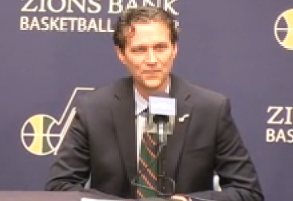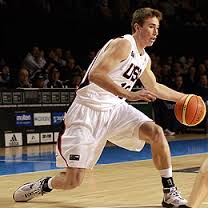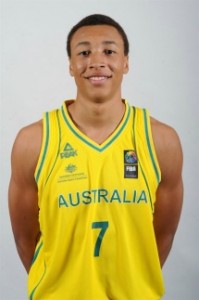 Perhaps no team in the NBA has moved on from its past and looked toward its future more than the Utah Jazz.
Perhaps no team in the NBA has moved on from its past and looked toward its future more than the Utah Jazz.
Virtually all of the ties to the great Jazz teams of the 1990s are gone. In their place are a rookie coach and a starting lineup that figures to have no one older than 24.
The Jazz won’t be much better than last season, when they lost 57 games, their most since arriving in Salt Lake City from New Orleans 35 years ago. In fact, given their inexperience on the court and the sidelines, they could be worse.
But with a group of enthusiastic kids playing for an energetic coach, the Jazz will be eminently more fun to watch.
Here’s five things to look for this season from the Jazz.
1. Quin Snyder’s new offense. My frame of reference has always been the Frank Layden remix of the Dick Motta offense known as the “flex.” Long-time assistant Phil Johnson learned it from Motta in the 1960s. When Layden left, Jerry Sloan – who played for Motta – adopted it. And when Sloan and Johnson left, Tyrone Corbin attempted to make it work.
The flex has been in Utah longer than the current roster has been on this planet. However, rule changes and roster  quality dynamics have forced the team to evolve away from what worked years ago. With a new coach in Quin Snyder, the Jazz will run something new for the first time in decades.
quality dynamics have forced the team to evolve away from what worked years ago. With a new coach in Quin Snyder, the Jazz will run something new for the first time in decades.
Snyder has worked under many great coaches, including Mike Krzyzewski, Larry Brown, Gregg Popovich, Doug Collins and Ettore Messina. He is smart enough to know the wheel does not need to be reinvented. Functionally, the new offense looks a little bit Duke, a little bit Spurs and a lot of primary and secondary ballhandlers getting touches after off-ball screens. This fits the roster where Trey Burke, Dante Exum, Gordon Hayward, Alec Burks and possibly Rodney Hood and Ian Clark will want to be able to do something with the ball in their hands on the perimeter.
Gone are the days of one player dominating the ball. There will be less standing and watching, and more passing with purpose. This offense is going to be fun to learn and watch.
2. Gordon Hayward’s leadership. Hayward did not make Team USA, just like he did not make that last-second heave to defeat Duke in the NCAA title game years ago. But between those two long shots, the kid from Brownsburg,  Indiana has grown up quite a bit.
Indiana has grown up quite a bit.
Hayward is the only member of the Jazz’s youth brigade to play at least 2,000 minutes in each of the last four seasons. He has been getting the crucial on-court education that separates him from the rest of his teammates. And he has attempted to make the most of it by being a legitimate multi-tool player who can find teammates just as well as he can find his own shot.
While Gordon has had a slow transition from being an offensive afterthought to the first option, putting the ball in his hands allows the 24-year-old to be more than a spot-up shooter. This season, he will look to incorporate his USA Basketball experiences in Utah and take that next step in leading this young group back to respectability.
3. Rudy Gobert, rotation player. The Jazz are bringing eight big men to training camp. The centerpiece is Derrick Favors, an emerging defensive force who works out with Karl Malone and will be entering his fifth year in the league at just 23 years old. Beyond him, it is a rogue’s gallery of talents, flaws, and characters.
The starting spot alongside Favors appears open, but the early idea was that the battle would be between Enes Kanter, motivated by a contract year, and former Wizards garbage-time man Trevor Booker. Whatever minutes remained would be  taken by zone-busting sharpshooter Steve Novak. It’s not the most fearsome rotation, but it is better than starting Marvin Williams at power forward, as the Jazz did last season.
taken by zone-busting sharpshooter Steve Novak. It’s not the most fearsome rotation, but it is better than starting Marvin Williams at power forward, as the Jazz did last season.
However, this idea is completely out of date with the overt emergence of Rudy Gobert, who looks like he is ready to play now, one year removed from foot surgery. After a dominating performance in the Las Vegas Summer League, the Frenchman made the world take notice with his inspired play in the FIBA World Cup.
Returning to Utah with a bronze medal around his neck, the sophomore deserves to play more than the 400 minutes he got as a rookie. He has size that matters and can help change the defensive culture of the team. I expect him to be a major fixture in the Jazz’s bigs rotation going forward.
RELATED: Jazz salaries and analysis
4. Overwhelming youth. When the Jazz were a championship contender, they had one of the league’s older rosters; their playoff rotation appeared more like an almanac at times. Times have changed as the only things the Jazz  contended for last season were ping-pong balls. The team bottomed out and nearly tied a franchise record for fewest wins in a season as it used a combination of ineffectual experience (Williams, Richard Jefferson, Andris Biedrins, John Lucas III) and systemically overlooked youth.
contended for last season were ping-pong balls. The team bottomed out and nearly tied a franchise record for fewest wins in a season as it used a combination of ineffectual experience (Williams, Richard Jefferson, Andris Biedrins, John Lucas III) and systemically overlooked youth.
This season the Jazz are even younger; just two of the 19 players in camp are 30 or older, while 15 will be 25 or younger by Halloween. Most of these players could be classified as “college age,” so hiring a former college coach makes sense. There will definitely be growing pains, but the Jazz should benefit from learning a new system together. Seniority appears to be replaced by a meritocracy, a sweeping change compared to the previous despotic regime.
5. Actual development and discovery. Last season was supposed to be about development and discovery. What we saw was Hayward taking more shots he wasn’t comfortable taking, Favors not getting the ball enough, and the not-so-newfound discovery that Corbin likes to start and play over-the-hill veterans over the plethora of lottery picks his bosses worked hard to attain.
This season will be one bereft of the former coach and all over-the-hill players. It’s really the start of a new era in Salt Lake City, and hopefully the unbridled youth paired with a coaching staff that will focus on development will mean this franchise has a very bright future. We will look to discover if Burke and Exum can play with one another; if the big men are ready to take the next step; if Hayward can be an All-Star; and so much more over the next seven months.
READ EVERY TEAM’S SEASON PREVIEW WITH OUR INDEX
Amar Smith is the managing editor of SLCDunk.com, the SB Nation Utah Jazz blog. Follow him at @SLCDUNK on Twitter and like him on Facebook.